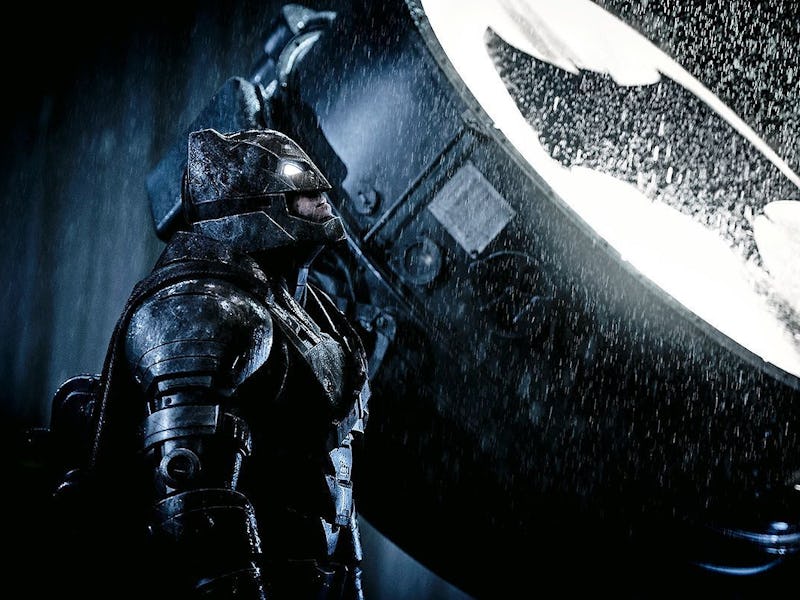You Can't Imagine 'Suicide Squad' Sans Batman's Influence
Is the summer's most contentious comic book movie just a weak Batman film?

To quote the now-aged meme, “Always be yourself! Unless you can be Batman. Then always be Batman.” If one is making an exciting summer comic-book blockbuster movie, the sentiment seems similar: the creative team should try to make an original film with its own pathos, cultural nuisances, unique characters and situations. But, hell, if you can make it into a Batman movie, too, wouldn’t you want to do that, too?
With Suicide Squad heading towards us like a crazy-out-of-control getaway car which seems to be careening dangerously in the street before it’s actually finished robbing the bank, fans and critics are trying out all sorts of different criteria to figure out how best to talk about the impending mess. Does the movie succeed tonally? Is it an entertaining action movie? Is Will Smith the real lead actor? How is DC building its new cinematic comic book movie empire? Is Suicide Squad the first movie ever marketed to an entirely imagined audience? But maybe we’re missing the real way to look at: it’s a faux-Batman movie.
Nailing down the exact sociological causes for the overwhelming popularity of Batman isn’t easy. And said task gets even tricker when the slippery nature of exactly who Batman is isn’t consistent. In The Caped Crusade Glen Weldon writes, “the mere existence of Adam West’s Batman breezily yet effectively rejects the notion that the only valid Batman is a grim, gritty badass.” An easy explanation for the tonal inconsistency of Batman and his supporting characters could be chalked up to the movement of the character between mediums, i.e. early TV and film Batman was more mainstream and palatable or “watered-down,* than the supposed “source material.” But that’s not really true in the long run. Because the weirdest part about Batman is the ways in which its fictional universe communicates with each of its mediums.
The microcosm of this unique game of narrative telephone is, of course, Harley Quinn, the anti-hero of Suicide Squad. Today, in Comic Con culture, Harley is a rebellious iconoclast character who was always, and is not currently, defined by association with the Joker. Famously, Harley was created in 1992 for Batman: The Animated Series. For many, The Animated Series represents a crossroads of peak-legit Batman stuff: the show could be watched by children safely, but was serious enough to be taken well, seriously by adults and comic book aficionados.
Since then, Harley Quinn has been reverse-engineered both consciously and organically into the larger monster of comic book culture. At this point, the character means something to a certain kind of fan that has nothing to do with her “origin,” which was arguably just a cheap plot device. And yet, any way you slice it, Harley Quinn and the Joker are still just characters who serve as accessories to the story of Batman. In comic books, it’s common for people once considered “side characters” to get their own ongoing title, but films are different.
In Rosencrantz and Guildenstern Are Dead, Tom Stoppard created comedic meta-fictional life with two of most famous side-characters of all (Rosencrantz and Guildenstern) from Shakespeare’s Hamlet. And yet, even there, where the point of the play is to explore the strange thinness of the characters, Rosencrantz and Guilderstern Are Dead is still commenting on Hamlet even if Hamlet himself isn’t what the story is “about”, which means even with Batman’s limited screen time in Suicide Squad, the presence of the Joker, Deadshot, Killer Croc, and Harley Quinn still means the story is interacting with Batman even if the film is not about Batman.
We’re seeing this again at the end of the year with Rogue One, the Star Wars version of Suicide Squad. Here’s a movie that isn’t about Darth Vader, but everyone is obsessed with seeing a glimpse of Darth Vader. What’s the source of the contemporary pop culture obsession with underdogs being given the limelight? Arguably, you could say all superhero stories (or big epics like Star Wars) are underdog stories to begin with. Batman starts at the bottom of a cave full of bats and works is way up to the top of the heroism chain. Luke Skywalker is a orphan in the Charles Dickens-tradition and so on. But over time, those once-humble heroes (or anti-heroes like Hamlet and Darth Vader) get too big, and their Rosencrantzes, Guildensterns, and Harley Quinns take over lead duties for awhile.
Still, just like you can’t imagine BB-8 having its own movie, or Rosencrantz and Guildenstern turning into a franchise of plays, perhaps there’s a reason why side characters are defined by their associations with symbiotic main character. If you bring in characters from Hamlet, audiences are going to think about Hamlet. And side-characters, like various members of the Suicide Squad from Batman are exactly the same.